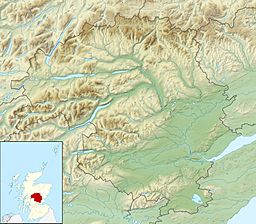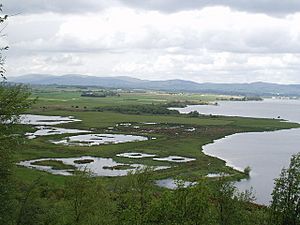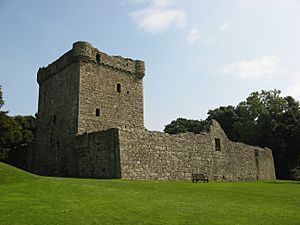Loch Leven (Kinross) facts for kids
Quick facts for kids Loch Leven |
|
|---|---|
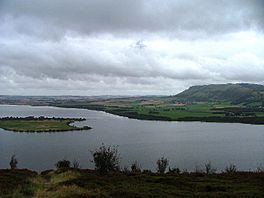
Looking north from Vane Farm
|
|
| Coordinates | 56°12′01″N 3°22′47″W / 56.20019°N 3.37963°W |
| Type | freshwater loch |
| Max. length | 5.24 km (3.26 mi) |
| Max. width | 4.18 km (2.60 mi) |
| Surface area | 1,611 ha (3,980 acres) |
| Average depth | 4.6 m (15 ft) |
| Max. depth | 13 m (44 ft) |
| Shore length1 | 23 km (14 mi) |
| Surface elevation | 106 m (348 ft) |
| Islands | Loch Leven Castle, St Serf's Island, Reed Bower, Alice's Bower, Scart Island |
| 1 Shore length is not a well-defined measure. | |
Loch Leven (which means Loch Lìobhann in Scottish Gaelic) is a large fresh water loch (a Scottish word for lake). You can find it in central Scotland, just east of the town of Kinross. The loch is shaped a bit like a triangle and is about 6 kilometers (3.7 miles) long.
Loch Leven used to be much bigger! Between 1826 and 1836, part of the loch was drained. This lowered the water level by about 1.4 meters (4 feet 7 inches). This made the loch 75% smaller than it was before. It also made some small islands appear and made existing ones much larger.
There are seven islands on the loch. The biggest one is St Serf's Inch. On another island, you'll find Loch Leven Castle. This is where Mary, Queen of Scots was held captive in 1567. You can visit the castle by taking a ferry from Kinross during the summer. Historic Environment Scotland runs this ferry.
Scientists think that the loch might be the site of an impact structure. This means a meteor or comet might have hit the area about 270 million years ago.
NatureScot, a Scottish nature organization, calls Loch Leven "one of Scotland's top natural assets." This is because it has a very rich ecosystem. It supports many different kinds of plants, insects, fish, and birds. It's especially important for birds that are migrating. They stop here on their long journeys between their breeding and winter homes. This is because the loch is in a low-lying area, has shallow, nutrient-rich water, a large surface, and islands for safe nesting. Loch Leven has many special conservation designations. It is even a national nature reserve (NNR).
Contents
Amazing Wildlife at Loch Leven
Loch Leven is the largest lowland loch in Scotland. This makes it a very important place for waterfowl (water birds). In the winter, up to 35,000 birds can be found here! These birds travel from many places, including Greenland, Iceland, Ireland, Siberia, and other parts of Europe.
Birds of Loch Leven
Loch Leven is especially important for pink-footed geese. Sometimes, as many as 20,000 of these geese are here. That's almost 10% of all the pink-footed geese in the world! Other birds that spend the winter at Loch Leven include greylag geese, whooper swans, goldeneyes, tufted ducks, pochards, teals, gadwalls, cormorants, and shovelers.
The loch is also a great place for birds to breed. It has one of the largest groups of breeding ducks of any inland area in Europe. The most common ducks are tufted ducks and mallards. You can also find gadwall, shoveler, shelduck, pochard, teal, pintail, and wigeon here.
Some birds, like mute swans, use the loch at the end of summer for moulting. This is when they lose their old feathers and grow new ones. During this time, they can't fly. The loch is big enough to help them stay safe from predators.
Fish and Invertebrates
The two main types of fish in Loch Leven are brown trout and perch. The trout from this loch are famous for their unusual color and great taste. Other fish living here include sticklebacks, pike, eels, and minnows. Some fish that used to live here are gone now. For example, Arctic char were affected when the loch's water level was lowered. Also, pollution and a dam on the River Leven caused Atlantic salmon to disappear.
The loch is home to many small creatures called invertebrates. These are a key food source for many birds, fish, and mammals. In the summer, large groups of tiny flies provide food for ducklings. Some rare beetles live here too, like the carrion beetle Thanatophilus dispar. Other invertebrates include water snails and different kinds of dragonflies and damselflies.
Mammals of Loch Leven
You can find otters around the loch and in the small streams that flow into it. Water shrews and water voles live along the banks of the ditches and streams. Six types of bats have been seen at the National Nature Reserve. These include Daubenton, brown long-eared, noctule, Nathusius, soprano, and common pipistrelle bat.
The number of grey squirrels is managed here. This has helped red squirrels to return to the woodlands around the loch. Other animals like foxes, mink, and brown rats are also present. Their numbers are also managed to protect nesting birds.
Plants of Loch Leven
The Loch Leven National Nature Reserve has many different plant species growing around its shores. Three of these plants are on the IUCN Red List, meaning they are at risk. These are the coral root orchid, Loch Leven spearwort, and lesser water-plantain. Other rare plants include holy grass, threadrush, and mudwort.
Lesser water-plantain, Loch Leven spearwort, mudwort, and threadrush grow in muddy, sandy, or gravelly areas by the loch. They need places that are sometimes exposed to air. Natural changes or careful management are needed to stop reeds or other water plants from growing over them. The coral-root orchid is found in only one spot on the reserve.
History of Loch Leven
People have lived around Loch Leven for thousands of years. The remains of a crannog have been found near Kirkgate Park. A crannog was a home built on an artificial island, likely during the Iron Age.
St Serf's Inch was once home to a religious community. First, it was a Culdee community, then an Augustinian one. This monastery was very old by the 12th century. A monk named Prior Andrew of Wyntoun wrote a famous history book called the Orygynale Cronykil of Scotland here.
Loch Leven Castle is famous for its connection to Mary, Queen of Scots. She was held prisoner here from 1567 to 1568. She was forced to give up her crown as queen. Later, she escaped with help from her jailer's family. After her escape, her army was defeated at the Battle of Langside, and she fled to England.
When the loch was partly drained in 1826–36, some old items were found. One was a sceptre (a royal staff) that seemed to be made of cane, with an ivory handle and silver. It had the words "Mary, Queen of Scots" on it. It was found near a spot called Mary Knowe, where she is thought to have landed after her escape.
On the western shore of the loch, facing the castle, is Kinross House. This house was built between 1684 and 1695 by its owner, the architect Sir William Bruce.
People visiting Loch Leven have always noticed its amazing wildlife. In 1692, Sir Christopher Lowther wrote that the loch had "fish every day gotten for store, none in Britain like, and consider the bigness of it as also for fowl." He also mentioned "great store of all kinds of wildfowl, of wild geese there being continually seen 3,000 or 4,000, and swans many."
In 1827, a special law was passed to help manage the water supply for industries along the River Leven. This work involved lowering the loch's water level and making the River Leven straighter. You can still see the old winding paths of the river in aerial photos today.
Fun Activities at Loch Leven
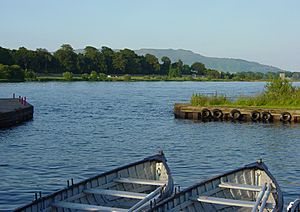
There's a path all around the loch called the Loch Leven Heritage Trail. It's designed for everyone to use. You can get onto the trail from seven different car parks around the loch. These include Kinross Pier, Kirkgate Park, Burleigh Sands, Loch Leven's Larder, Findatie, RSPB Loch Leven car park, and the Cashmere Factory car park. The trail was finished in 2014. By 2016, about 200,000 people were using it each year!
The Royal Society for the Protection of Birds (RSPB) has a visitor center on their part of the reserve. In 2016, about 70,000 people visited it. The center has a shop, a café, a room for watching birds, and educational areas. It also has toilets and marked trails that lead to three bird hides. There are three more open hides located around the loch for birdwatching.
Loch Leven is also famous for the sport of curling. The Kinross Curling Club, started in 1668, is said to be the oldest in the world! The loch used to host huge outdoor curling tournaments called the Grand Match or Bonspiel. However, the ice hasn't been thick enough for this since 1959. Even though the winter of 2010/11 was very cold, only informal matches were held on the loch due to safety worries.
The loch is also a popular spot for angling (fishing), mainly for brown trout. People also come here for wildfowling (hunting wild birds).
Protecting Loch Leven's Nature
| Loch Leven National Nature Reserve | |
|---|---|
|
IUCN Category II (National Park)
|
|
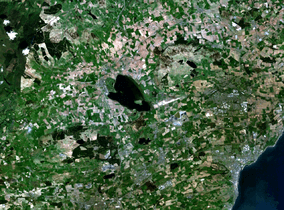
Satellite photograph of Loch Leven and the surrounding area
|
|
| Area | 1,823 ha (7.04 sq mi) |
| Designation | NatureScot |
| Established | 1964 |
| Loch Leven NNR | |
| Official name: Loch Leven | |
| Designated: | 5 January 1976 |
| Reference #: | 72 |
Loch Leven is the main part of the Loch Leven National Nature Reserve (NNR). This reserve covers 1,823 hectares (4,500 acres) of the loch and its islands. NatureScot manages the NNR. The wetlands on the southern shore are managed by the Royal Society for the Protection of Birds (RSPB). Fishing and shooting activities are managed by Kinross Estate. Castle Island is managed by Historic Environment Scotland, who also run the ferry to the island.
Loch Leven was first named a National Nature Reserve in 1964. It was re-declared in 2002 and made larger to include the RSPB Loch Leven section. The NNR is classified as a Category II protected area by the International Union for the Conservation of Nature. This means it's a very important area for nature.
Because it's so important for wildlife, Loch Leven has several special conservation titles. It's a Site of Special Scientific Interest (SSSI), a Special Protection Area (SPA), and a Ramsar site. These titles help protect the loch's unique environment.
There are also places around Loch Leven that are protected for their historical importance. Loch Leven Castle and St Serf's Priory are both Scheduled Monuments. Kinross House is a Category A listed building, which means it's a very important historic building. Its gardens are also listed in the Inventory of Gardens and Designed Landscapes in Scotland.
See also
 In Spanish: Lago Leven para niños
In Spanish: Lago Leven para niños


